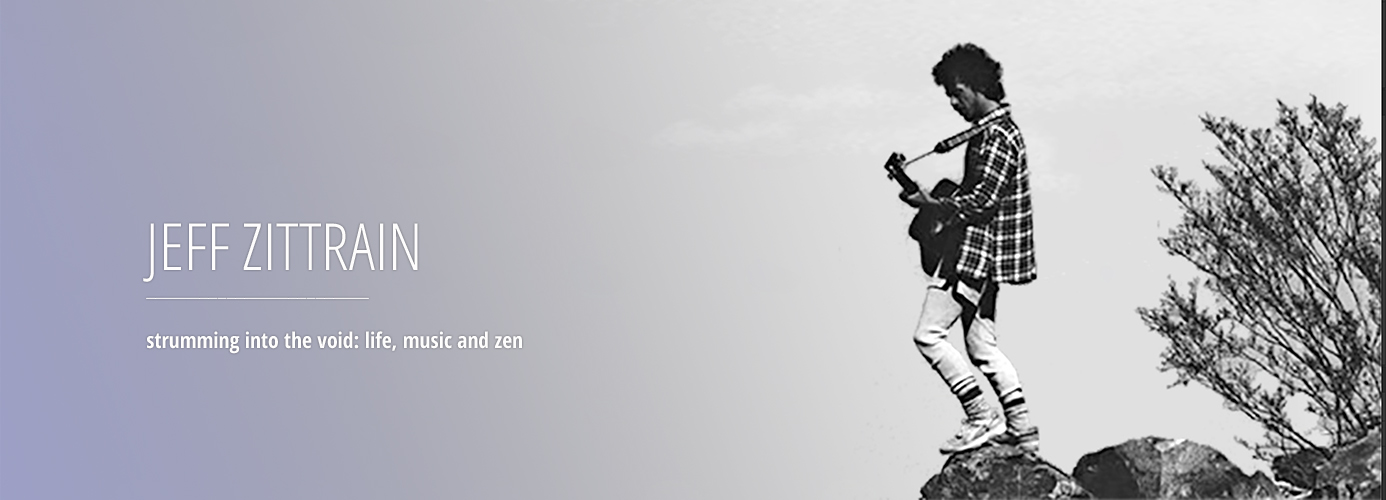Top Ten Personally Influential Albums
by Jeff Zittrain
Day 1
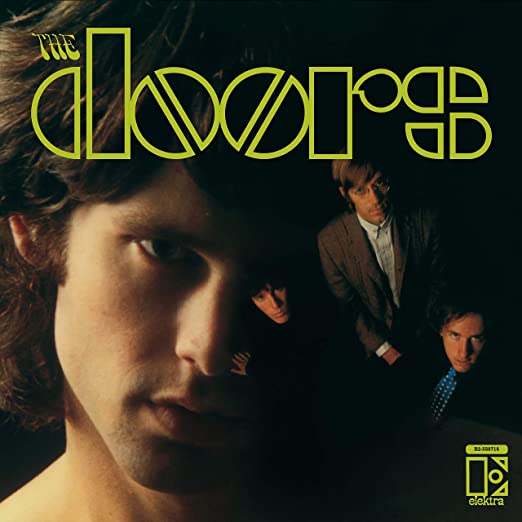
The Doors: The Doors
Robert Leigh nominated me for the 10 influential albums craze. Here’s 1/10. I like all the Doors albums but this is how I learned to jam, by learning how to improvise the solo on Light My Fire. I even had a keyboard bass for my left hand, just like Ray. Smart lyrics about philosophical reality and the scary and exuberant nature of existence. And I met a beautiful girl by turning her onto this band – I think she therefore saw some of Jim in me. She gave me the American Poet poster and the Doors Complete sheet music. I was 17 and the Lizard King – I could do anything.
Day 2 of 10 albums that influenced you.
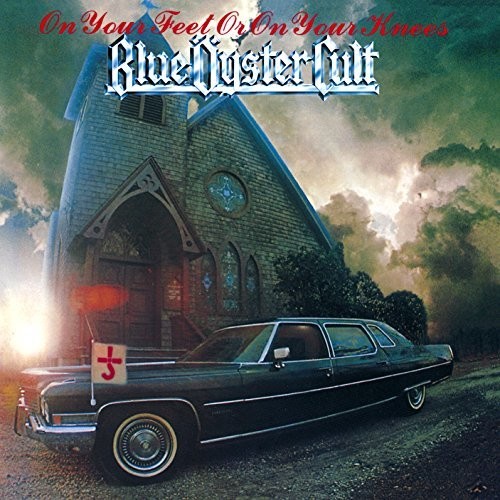
Blue Oyster Cult: On Your Feet or On Your Knees
I bought this double album in high school without knowing a single song on it. I was hooked from the first note of the first song. BOC was known for an eerie somewhat sinister vibe on their studio recordings but live I hear so much exuberance and fun along with the edge. Up until this point, I think I didn’t realize you were allowed to have this much fun. No holds barred over-the-top guitar heaven and a happening band that knows how to jam. The Bouchard rhythm section lays down a sizzling driving boogie-derived engine while Buck Dharma’s lead guitar is melodic and swinging and joyful – the whole thing is bursting and almost careening out of control but not quite. There’s a reason Flaming Telepaths play most of the songs from this album.
Day 3/10 of Influential Albums to me.
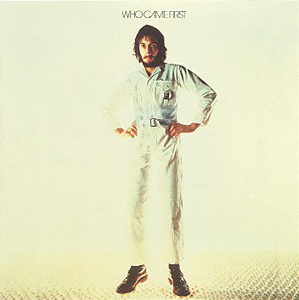
Pete Townshend: Who Came First
I graduated college and spent the summer of 1985 at a life crossroads, trying to decide if I would go to grad school or just move to California. In September I transcended both options and bought a 1-way ticket to Europe, choosing only 4 cassettes to bring with me. I listened to this album for hours on trains, hikes, and hostels while thinking about what to do with my life.
Pete Townshend’s first solo album was also a break from his previous life, an immensely personal statement away from his famous band, searching for spiritual meaning beyond ego, ironically while playing all the instruments himself in a “gynormous ego trip” as he puts it in the liner notes. I loved the joy in simplicity and sweetness after the bombast of The Who, yet it still rocked “Pure and Easy” more than The Who’s version – realizing music is spirit, the “simple secret of the note in us all – IN US ALL!”
Near the end of my trip, while I was living in a little village on Crete, I wrote out the words to “I Am Content” with a drawing of my surroundings. And the bridge from “Let’s See Action” still sometimes gives me peace from the fray – “I’ve been running from side to side, now I know for sure that both sides lie…I don’t know where I’m going, I don’t know what I need, but I’ll get to where I’m gonna end up, and that’s all right by me.”
Not totally sure if that remains true, but I’ve continued to seek the inspiration by playing my own version of “Time is Passing” ever since – “Don’t hear it in your needs and don’t hear it in your grieves, just hear it in the sound of time a-passing…it’s only by the music, I’ll be free.”
Day 4/10 of Influential Albums.
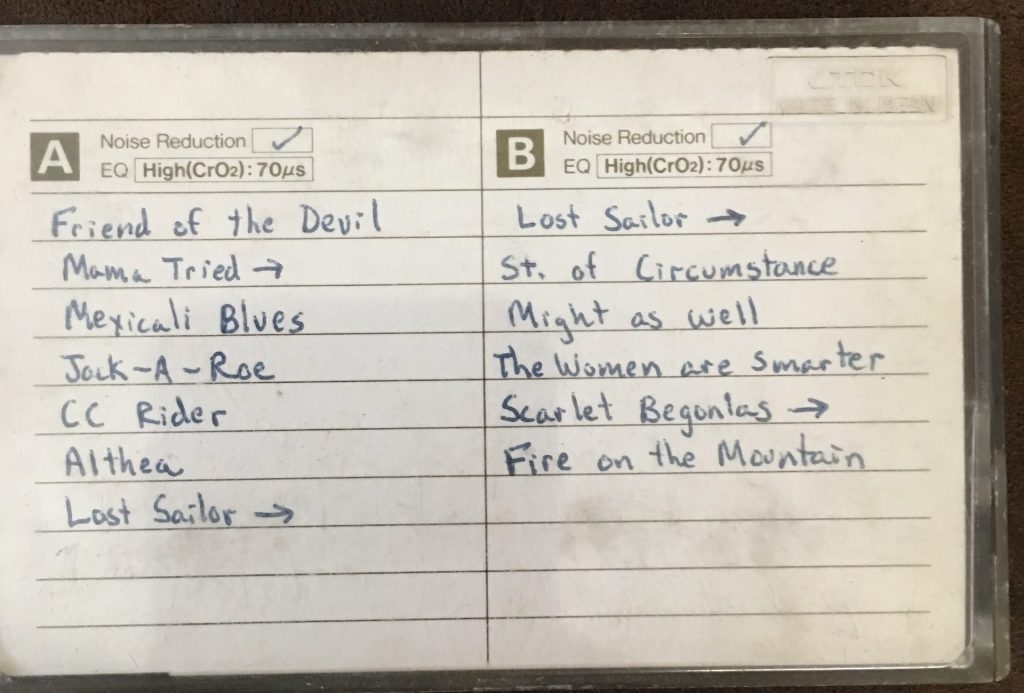
Grateful Dead: Salt Palace 8/12/81
I will step outside of the box here and use this cassette bootleg of “Salt Lake City 8/12/81” that opened me to the world of live Grateful Dead. It flies under the radar in GD lore, but it was the cleanest bootleg sound I’d heard to date, and it allowed me to experience a vibe that was hard to put my finger on – supremely relaxed and intense at the same time.
I couldn’t place it as any music I’d heard before. The occasional sloppiness, with between song tuning, missed lyrics and Bob Weir sounding like he has a sore throat, is casually shrugged off by the band as they pursue this strangely captivating vibe. I knew “Friend of the Devil” but not as a deep dirge with guitar and keyboard solos. “Mama Tried>Mexicali” sounded like country but not any country I’d been to. “C.C. Rider” was a blues but so open ended. “Althea” I absolutely couldn’t place at all – the style or the name. “Lost Sailor>Saint of Circumstance” was some kind of jazz space journey that ended with a genuinely inspired gospel-esque call and response: “Sure don’t know what I’m goin’ for, but I’m gonna go for it for sure” – that sentiment summed up the whole tape for me. “How ’bout you? What the f*ck you gonna do now?” Bobby yelled encouragement at the end of that call and response and I – I took the road less traveled, and that has made all the difference.
The less-traveled road is in large part the vision I could sense in the initial vibe. The seemingly disjointed quality of both the songs and the jams actually allows for new connections to be made, with seemingly endlessly new connections revealed on every repeated listening. The sloppiness is a necessary part of the package because it’s actually exploring a place that is deep and free and open – emotionally, spiritually, individually, and even collectively. The band – and us – are ultimately hooked in and part of something transcendent. As they declare in Scarlet Begonias, “everybody’s playing in the heart of gold band.” After all, as I saw somewhere at a live show once, “In the long run, we’re all Dead.”
Influential Albums day 5/10.
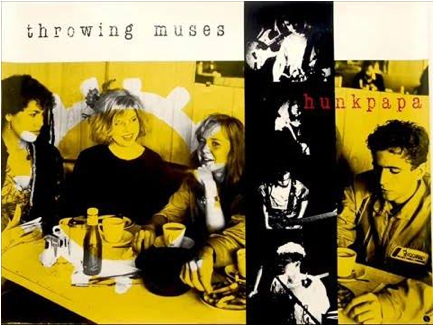
Throwing Muses: Hunkpapa
In 1988 a high school friend recommended I see Throwing Muses at the Berkeley Square (one of the first venues I had played in CA) and I went without knowing a single song. It remains one of the best shows I’ve ever seen. Kristin Hersh looked like a possessed Brownie being sacrificed on the altar of music flanked by a smiling blonde cheerleader with a Les Paul and Marshall stack and a tall grooving bassist with dreads, while the drummer – the only guy in the band – unleashed a remarkably hypnotic pounding that fulfilled the overall tribal energy. It was intense, edgy and somehow fun and celebratory all at once.
Their sound was meatier live, but Hunkpapa showcases the range of that era, moving from the truly dangerous “Mania” to the impossibly sweet “Dragonhead.”
Speaking of which, I also found myself singing vocal hooks about “too much mascara runs when you sleep” “where’s my husband” “if you don’t think I’m pretty I understand…just don’t think you won’t die by a woman’s hand” and the surrealistically suggestive “I swallow creepy things” (to which Tanya Donelly then cooed “don’t go back to sleep”).
In 1997 I saw Tanya Donelly at a small record store release for her first solo album “Lovesongs for Underdogs”, which really captures a glorious pulsing, glowing, cascading ecstasy that doesn’t stop with, um, one shot. (She would later write a song called Kundalini Slide). I didn’t even have a cd player at the time, so I bought one just to be able to hear that album.
I’ve since played two of Tanya’s solo songs in bands, and I’ve been teaching Kristin’s memoir “Rat Girl” for the past two years, which I (only partly facetiously) call the greatest book of all time.
To my ears, their sound developed on later TM cd’s (Particularly The Real Ramona and University) and both Kristin and Tanya’s solo projects, but this is the most influential – the one that started it all for me back in 1988.
Influential Albums #6/10
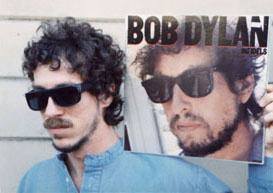
Bob Dylan: Infidels
A picture is worth a thousand words. I will drop the mic.
Personally influential albums, Day 6/10 (this time with feeling…)
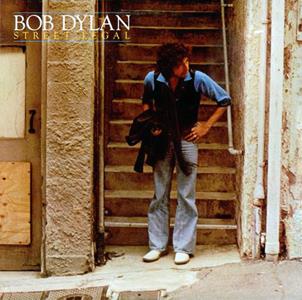
Bob Dylan: Street Legal
Yes, this is another Day 6. I love Infidels but I don’t consider it my most influential Dylan – I just couldn’t resist using the photo from yesterday. Most influential Dylan is hard to choose, as I’ve loved and played songs from throughout his career, but I’m going to go with the under appreciated Street Legal. To be even less predictable, I’m doing it because of the singing. He always knew how to turn a phrase, and convey a sense of great meaning in every declaration. But this was the album to me where his voice shines through with power and intensity, not as a troubadour or sardonic critic, but as real-time emotion, where he holds notes and rides the music with energy and vulnerability.
It’s world-weary but clear-eyed, with lines like “I have dined with kings, I’ve been offered wings, and I’ve never been too impressed” and “If you don’t believe there’s a price for this sweet paradise, remind me to show you the scars.” Speaking of which, “Where Are You Tonight?” is the masterpiece of the album to me. Desperation and swagger and vision all at once, with rich imagery of internal and external battles, a slick groove, gospel backing vocals and – yay – a great guitar solo at the end. I got to play that song once sitting in with a band at a Dylan Tribute show. That was fun.
“There’s a new day at dawn and I’ve finally arrived.
If I’m there in the morning, baby, you’ll know I’ve survived.
I can’t believe it, I can’t believe I’m alive,
But without you it just doesn’t seem right.
Oh, where are you tonight?”
His next album was Slow Train Coming, so the “you” here ended up being God (for at least 3 albums) – at this point he’s referring to a woman but sexual desire can “wind back the clock and turn back the page of a book that no one can write” – it was all transcendent.
Personally Influential Albums Day 7/10.
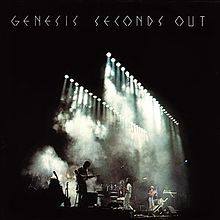
Genesis: Seconds Out
A friend once remarked to me after hearing my solo on one of my songs “Well, you aren’t afraid to go for the big statement.” The ambition of this recording moves me. Swinging for the fences, and knocking it out of the park. A glorious version of the epic Supper’s Ready with Steve Hackett’s guitar on the climactic New Jerusalem section besting his work on the studio cut. And Phil Collins wrings beautiful meaning out of Peter Gabriel’s lyrics – I wrote a 7-page paper on that song for my Bible as Literature class in college. Phil does the same with the orgasmic Musical Box (Closing Section) on here – and now Z-Trane spontaneously throws that classic classical ending onto any song we’re playing with just a head nod from me. Firth of Fifth has one of the greatest guitar notes of all time, and Carpet Crawlers is the song that got me into Genesis in the first place. As I wrote in a Right Action column, I used to come home from work every day and lie in the dark and listen to this version of that song – transporting me from this plane to a rich and beautiful and profound other world. I still play that song on the piano. “We’ve got to get in to get out.”
Personally Influential Albums Day 8/10.
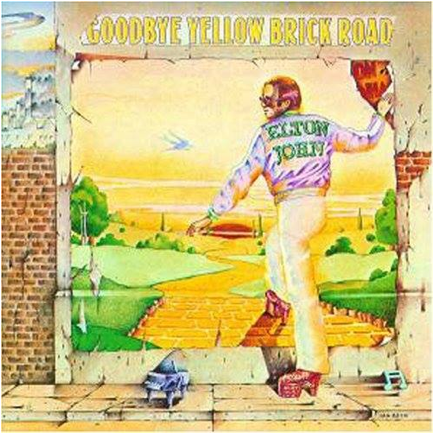
Elton John: Goodbye Yellow Brick Road
This was the first full album I bought beyond 45’s. I remember opening it up and looking at the amazing varied artwork/lyrics for each song and waiting to follow along with the first track. Which was “Funeral for a Friend” so I was waiting for what seemed like 20 minutes and wondering if I had done something wrong…but still the sounds were so cool and the song patiently and confidently morphed through so many styles and changes until it finally just rocked out with “Love Lies Bleeding”. A great preview of the whole album where – like The White Album – every song has its own unique feel. And – also like The White Album – every song was great, not just the big hits.
I would go on to buy five more Elton John records and still had no idea what “filler” was. Finally my mom got tired of hearing me play “Your Sister Can’t Twist (But She Can Rock and Roll)” about 10 times in a row and thought I should expand my horizons so she bought me “Band on the Run” – she knew I liked the song because I already had the single. Now I knew what filler was. No White Album there. Three great songs (Title track, Jet, 1985) and the rest…made me appreciate EJ even more because all of his songs were completely engaging. Beautiful harmonies, melodies, consciously poetic and totally edgy (for a grade-schooler) lyrics, and awesome piano playing, especially to a kid who was learning the piano. I remember playing the famous intro of “Bennie and the Jets” for some friends in my school music room and even the teacher coming over and giving me a thumbs up.
Elton would produce his share of filler beginning with Rock of the Westies (as well as some worthwhile later period songs) but his classic period was my entry into the joys of listening to albums beyond 45’s – music that presented itself as art and treated me like a thoughtful fan – I could read the lyrics, look at pictures, and see who played exactly what instrument on each song. The cover nails it – magically stepping out of tattered life and leading me into a beautiful magical world – of which I’m still partaking.
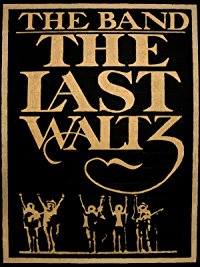
The Band : The Last Waltz
I saw this movie my freshman year of college and the world opened up in a new way, connecting me with something both historical and elemental. The music and visuals are weirdly timeless – evoking the pastiche of an American past somewhere around the 19th century, but rooted in a tradition that stretches all the way back to biblical times and is carried into the present. Songs about riverboats and gambling and the civil war are also about salvation and sin, and are played on electric instruments with a rock urgency. Deeply felt grooves, wild keyboards, ragged brilliant 3-part (and more) vocals, and ripping guitar. This record of The Band’s Farewell Concert captures truly inspired versions of not only most of their significant songs, but it also demonstrates the value and honor and musicality of being the world’s greatest and coolest backup band, with special guests Van Morrison, Eric Clapton, Joni Mitchell, Muddy Waters, Neil Young, Emmylou Harris, The Staple Singers, and Bob Dylan stepping in front yet carried by The Band through folk, blues, rock, Dixieland, gospel and country in a visionary quilt of American music. Everyone sings with each other, everyone gives 110%, and everyone seems to be having the time of their lives. As the tagline said: “It started as a concert – it became a celebration.” And it made me think – why not do that every time you play…
Taken as a whole it’s like stepping outside of life’s carnival to show it to us from a larger perspective. The last side is from the studio, where the haunting theme and other songs in The Last Waltz Suite also occupy a special timeless space, both supremely earthy and transcendent. In our beginning is our end and in our end is our beginning. And it’s all out of the blue. After reminding us that we all carry an undefinable Weight even beyond our temporary joys and heartaches and we all need community, they are free to get back to Miss Fanny, and leave us to contemplate where we fit in.
Personally Influential Albums Day 10 (yikes) of 10.
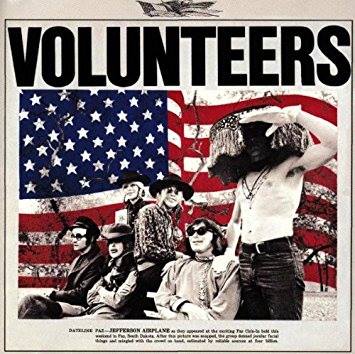
Jefferson Airplane: Volunteers
Some people have asked where the hell is my final choice. I was cruising through 1-9, and at the absolute deadline I realized there were too many that couldn’t go unrecognized. I could write a good essay on how and why any one of these have influenced me (and I already have in two of my Right Action columns). The other final contestants were Pink Floyd: Animals, Derek and the Dominos: Layla, The Beatles: White Album, and Santana: Moonflower. However, since I’ve already written about some of those, and in deference to the times in which we live, I will go with Jefferson Airplane’s Volunteers.
I bought this album in high school in 1979, 10 years after its original release. It seemed like history – a cool history – and also fresh to me. Something about it is so rooted in its time, yet reaches beyond nostalgia. From the cover to the lyrics, it is unapologetically political and ballsy, from Grace Slick’s sweet and powerful harmony singing “Up against the wall motherfucker” to the exuberant wildness of the title song with its repeated calls to action “Got to revolution!” and the album’s overall claim that WE are the true soul of the country, the volunteers of America. Add in Jorma’s signature guitar leaping out of every track and great jams on Good Shepherd, Hey Frederick, and Wooden Ships (which to my ears bests the more famous CSN version because of the power of the jam and Grace’s vocals) and this is one vital record. It made me feel like rock music really could directly change the world, and have fun doing it.
Was that a pipe dream? That may be an apt metaphor for the band that wrote White Rabbit and the ultra psychedelic After Bathing at Baxter’s – but its revolutionary spirit still sounds as potent as ever. Some part of the battle of 1969 is still raging. And we always need to give a big middle finger to overly authoritarian powers that be, in any age. After all, what could seem more relevant today than the powerful ending of We Can Be Together with Jorma wailing and everyone singing: “Up against the wall motherfucker, Tear down the wall, Tear down the walls!”
When I hear that, I still believe. Pick up the cry, people. Got to revolution.
Addendum:
I’m still thinking about the “10 Personally Influential Albums” thing.
So I will do a Nate Silver impersonation.
Here are some statistics for each pick. The year the album was originally released and then the year I started listening to it.
The Doors – 1967/1979
On Your Feet – 1974/1979
Who Came First – 1971/1985
Salt Palace – 1981/1984
Hunkpapa – 1988/1988
Street Legal – 1978/1988
Seconds Out – 1977/1982
Goodbye Yellow Brick Road – 1973/1973
The Last Waltz – 1978/1981
Volunteers – 1969/1979
Before I get into the numbers, I notice 4 (double) live albums. (BOC, Genesis, Dead, Band). That makes sense, because of the influence on my own live playing.
Regarding the numbers: I notice that only 2 of the albums did I listen to at the time of the release, Goodbye Yellow Brick Road and Hunkpapa.
So I wasn’t necessarily riding the current zeitgeist. I think music appreciation often feels like some kind of cool research to me, looking for different ideas and times. The popular stuff in high school that I mostly heard on the radio mostly didn’t seem as deep so didn’t have as much of an effect on me. The past seemed cooler. As a prime example, although they didn’t make the cut, I remember discovering Traffic in 11th grade and thinking they seemed like a particularly cool hidden treasure that no one else knew about. (And I did get Steve Winwood’s Arc of a Diver when it came out in 1981)
Five (Half) of the records were released between 1973-1978, when I was 10 -15.
Of the other half, 2 were in the 60s, 2 in the 80s, and one from 1971.
Regarding when I listened, most of them (7) were in high school/college: 3 were 1979, 4 were between 81-85.
The other 2 were 88 when I first moved to CA and 73 where it all began.
That all makes sense as it’s about influential albums, so those hit me in my developing years.
Incidentally, there was a post going around that your life can be categorized by the song that was #1 on the day you turned 14. Mine was “Gonna Fly Now (Theme from Rocky)”. I’ll take that. And yes, I had that record too.
